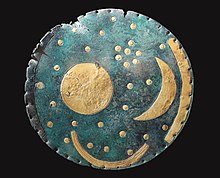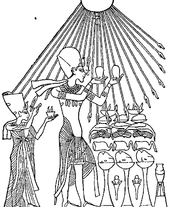Solar symbol

Asolar symbolis asymbolrepresenting theSun. Common solar symbols include circles (with or without rays), crosses, and spirals. In religious iconography, personifications of the Sun or solar attributes are often indicated by means of ahaloor aradiate crown.
When the systematic study ofcomparative mythologyfirst became popular in the 19th century, scholarly opinion tended to over-interpret historical myths and iconography in terms of "solar symbolism". This was especially the case withMax Müllerand his followers beginning in the 1860s in the context ofIndo-European studies.[1]Many "solar symbols" claimed in the 19th century, such as theswastika,triskele,Sun cross,etc. have tended to be interpreted more conservatively in scholarship since the later 20th century.[2]
Solar disk
[edit]
The basic element of most solar symbols is the circular solar disk.
The disk can be modified in various ways, notably by adding rays (found in the Bronze Age in Egyptian depictions ofAten) or across.In the ancient Near East, the solar disk could also be modified by addition of theUraeus(rearing cobra), and in ancient Mesopotamia it was shown withwings.
Bronze Age writing
[edit]Egyptian hieroglyphshave a large inventory of solar symbolism because of the central position of solar deities (Ra,Horus,Atenetc.) inancient Egyptian religion.
The "Sun" logogram in earlyChinese writing,beginning with theoracle bone script(c. 12th century BC) also shows the solar disk with a central dot (analogous to the Egyptian hieroglyph); under the influence of the writing brush, this character evolved into a square shape (modernNhật).
Classical era
[edit]
In the Greek and European world, until approximately the 16th century, the astrological symbol for the Sun was a disk with a single ray,![]() (U+1F71A🜚ALCHEMICAL SYMBOL FOR GOLD). This is the form, for example, in JohannesKamateros' 12th centuryCompendium of Astrology.[4]
(U+1F71A🜚ALCHEMICAL SYMBOL FOR GOLD). This is the form, for example, in JohannesKamateros' 12th centuryCompendium of Astrology.[4]
Astronomical symbol
[edit]The modernastronomical symbolfor the Sun, a circled dot (U+2609☉SUN), was first used in the Renaissance.
Rayed depictions
[edit]
A circular disk with alternating triangular and wavy rays emanating from it is a frequent symbol or artistic depiction of the sun.
Antiquity
[edit]The ancient Mesopotamian "star ofShamash"could be represented with either eight wavy rays, or with four wavy and four triangular rays.
TheVergina Sun(also known as the Star of Vergina, Macedonian Star, or Argead Star) is a rayed solar symbol appearing inancient Greek artfrom the 6th to 2nd centuries BC. The Vergina Sun appears in art variously with sixteen, twelve, or eight triangular rays.
Bianchini'splanisphere,produced in the 2nd century,[5] has acircletwith rays radiating from it.[6]
Sun with face
[edit]The iconographic tradition of depicting the Sun with rays and with ahuman facedeveloped inWestern traditionin the high medieval period and became widespread in theRenaissance,harking back to the Sun god (Sol/Helios) wearing aradiate crownin classical antiquity.
Sunburst
[edit]Thesunburstwas thebadgeof kingEdward III of England,and has thus become thebadge of officeofWindsor Herald.
Modern pictogram
[edit]
The modern pictogram representing the Sun as a circle with rays, often eight in number (indicated by either straight lines or triangles; UnicodeMiscellaneous Symbols☀U+2600;☼U+263C) indicates "clear weather" inweather forecasts,originally intelevisionforecasts in the 1970s.[8] The Unicode 6.0Miscellaneous Symbols and Pictographs(October 2010) block introduced another set of weather pictograms, including "white sun" without rays 1F323🌣,as well as "sun with face" U+1F31E🌞︎︎.
Two pictograms resembling the Sun with rays are used to represent the settings ofluminanceindisplay devices.They have been encoded in Unicode since version 6.0 in the Miscellaneous Symbols and Pictographs block under U+1505 as "low brightness symbol" (🔅) and U+1F506 as "high brightness symbol" (🔆).[9]
Crosses
[edit]The "sun cross","solar cross ", or" wheel cross "(🜨) is often considered to represent the four seasons and the tropical year, and therefore the Sun (though as anastronomical symbolit represented the Earth).[a] In theprehistoric religionofBronze Age Europe,crosses in circles appear frequently on artifacts identified as cult items. An example from theNordic Bronze Ageis the "miniature standard" withamberinlay revealing a cross shape when held against the light (National Museum of Denmark).[10]The Bronze Age symbol has also been connected with thespokedchariotwheel,which at the time was four-spoked (compare theLinear Bideogram 243 "wheel"𐃏). In the context of a culture that celebrated theSun chariot,the wheel may thus have had a solar connotation (c.f. theTrundholm sun chariot).
TheArevakhach( "solar cross" ) symbol often found in Armenianmemorial stelaeis claimed as an ancient Armenian solar symbol of eternity and light.[11]
SomeSámi shamandrums have theBeaiviSámisun symbol that resembles asun cross.
Theswastikahas been a long-standing symbol of good fortune inEurasiancultures: its appropriation by the Nazi Party from 1920 to 1945 is a brief moment in its history. It may be derived from the sun cross,[12]and is another solar symbol in some contexts.[13] It is used amongBuddhists(manji),Jains,andHindus;and many other cultures, though not necessarily as a solar symbol.
The "Black Sun"(German:Schwarze Sonne) is a 'sun wheel' with twelve-foldrotational symmetry.The design was incorporated as a mosaic into a floor ofWewelsburg Castleduring theNazi eraand may have been inspired byAlemannicIron Age swastika-like designsin Migration-periodZierscheiben.[14]It has been adopted by modernSatanistgroups andneo-Nazis.
The "Kolovrat", or in PolishSłoneczko,represents the Sun inSlavic neopaganism.
-
Sun cross form ofswastika,official symbol of theGerman Faith Movement(1934–1945)
-
Slavic Kolovrat/Słoneczko
Modern flags and emblems
[edit]Official insignia which incorporate rayed solar symbols include theflag of Uruguay,theflag of Kiribati,some versions of theflag of Argentina,theIrish Defence Forces cap badge,and the1959–1965 coat of arms of Iraq.
The depictions of the sun on the flags ofthe Republic of China (Taiwan),Kazakhstan,Kurdistan,the Brazilian state ofPernambuco,andNepalhave only straight (triangular) rays; that ofKyrgyzstanhas only curvy rays; while that ofthe Philippineshas short diverging rays grouped into threes.
Another rayed form of the sun has simple radial lines dividing the background into two colors, as in themilitary flags of Japanand theflag of North Macedonia,and in the top parts of the flags ofTibetandArizona.
Theflag of New Mexicois based on theZia sun symbolwhich has four groups of four parallel rays emanating symmetrically from a central circle.
-
Flag of Argentina
-
Flag of Arizona (USA)
-
Flag of the Republic of China (Taiwan)
-
Flag of theJapan Ground Self-Defense Force
-
Flag of Kazakhstan
-
Flag of Kiribati
-
Flag of Kurdistan
-
Flag of Nepal
-
Flag of New Mexico (USA)
-
Flag of North Macedonia
-
Flag of the Philippines
-
Flag of Tibet
-
Flag of Uruguay
-
Flag of Pernambuco (Brazil)
Code points in Unicode
[edit]- U+2609☉SUN
- U+2600☀BLACK SUN WITH RAYS(A more accurate term might be "solid colour". The actual colour is an implementation choice, for example☀,☀.)
- U+263C☼WHITE SUN WITH RAYS(A more accurate term might be "outlined". The actual colour is an implementation choice.)
- U+1F728🜨ALCHEMICAL SYMBOL FOR VERDIGRIS
- U+1F323🌣WHITE SUN(A more accurate term might be "outlined". The actual colour is an implementation choice.)
- U+1F31E🌞SUN WITH FACE
- U+1F506🔆HIGH BRIGHTNESS SYMBOL
- U+1F71A🜚ALCHEMICAL SYMBOL FOR GOLD
- U+2F47⽇KANGXI RADICAL SUN
- U+131F4𓇴EGYPTIAN HIEROGLYPH N006
- U+2299⊙CIRCLED DOT OPERATOR
See also
[edit]- Astrological symbols– Symbols denoting astrological concepts
- Astronomical symbols– Symbols in astronomy
- Blue Sky with a White Sun– National emblem of the Republic of China
- Beaivi– Sami sun-deity, name of sun in Sami
- Black Sun (symbol)– Neo-Nazi and esoteric symbol
- Lauburu– Basque cross
- Monad (Greek philosophy)– Philosophical concept of a most basic substance, or supreme being
- Self in Jungian psychology– Psychological concept
- Solar deity– Sky deity who represents the Sun
- The Sun in culture– Depictions of the Sun in culture
- Sun (heraldry)– Symbolic form used in heraldry
- Sun of May– National emblem of Argentina and Uruguay
- Vergina Sun– Rayed solar symbol
- Winged sun– Symbol of divinity, royalty and power
Notes
[edit]- ^Since at least 1988, the International Astronomical Union has deprecated use of planetary symbols in journal articles.The IAU Style Manual(PDF).The International Astrophysical Union. 1989. p. 27.Archived(PDF)from the original on June 21, 2018.RetrievedAugust 20,2018.
References
[edit]- ^C. Scott Littleton (1973).The New Comparative Mythology: An Anthropological Assessment of the Theories of Georges Dumézil.University of California Press. p. 34.ISBN978-0-520-02404-5..See also R. F. Littledale, "The Oxford Solar Myth, A Contribution to Comparative Mythology" in:Echoes from Kottabos,London (1906), 279–290 for a satire on this effect.
- ^notably ciriticized byRichard Chase,The Quest for Myth(1951); see alsoAstralkultfor the more general tendency of over-interpretation of mythology in terms ofastral mythology.
- ^Jones, Alexander (1999).Astronomical papyri from Oxyrhynchus.pp. 62–63.ISBN0-87169-233-3.
- ^Neugebauer, Otto; Van Hoesen, H. B. (1987).Greek Horoscopes.pp.1,159, 163.ISBN9780871690487.
- ^"Bianchini's planisphere".Florence, Italy: Istituto e Museo di Storia della Scienza (Institute and Museum of the History of Science).Retrieved2010-03-17.
- ^Maunder, A. S. D. (1934). "The origin of the symbols of the planets".The Observatory.57:238–247.Bibcode:1934Obs....57..238M.
- ^Michon, Solange (1987). "Un moine enlumineur du XIIe siècle: Frère Rufillus de Weissenau" [Brother Rufillus de Weisenau: a monastic illuminator of the twelfth century].Journal of Swiss Archaeology and Art History(in French).doi:10.5169/seals-168847.
- ^Daniel Engber,Who Made That Weather Icon?,New York Times,23 May 2013.
- ^"Miscellaneous Symbols and Pictographs"(PDF).Unicode Consortium. 2023.
- ^entryArchived2007-09-28 at theWayback Machineat theNebra sky diskexhibition site (landesmuseum-fuer-vorgeschichte-halle.de)
- ^Айк Демоян «Армянские национальные символы» = «Հայկական ազգային խորհրդանշաններ». — Ереван: «Пюник», 2013.
- "Մամլո հաղորդագրություն -" Շուշիի ազատագրման 20-ամյակ "(ոսկի) [News release - A golden coin dedicated o the 20th anniversary of the Liberation of Shushi]"(PDF).Central Bank of Armenia.24 January 2012. Archived fromthe original(PDF)on 3 October 2013.Retrieved4 October2013.see theimage of the coin
- "Հայաստանի Հանրապետության Կառավարության 2002 Թվականի Հունվարի 7-ի N 6 Որոշման Մեջ Փոփոխություններ Կատարելու Մասին".Armenian Legal Information System. 18 April 2012.Retrieved4 October2013.,see thelogo of the Customs Service of Armenia
- The Council of the city Yerevan,the seal of Yerevan,2010, see thelogo of Yerevan
- Ministry of Justice of RA,about the medals and decorations,2007
- The government of Armenia,symbol of the cooperation «Armenia-Diaspora»Archived2013-09-27 at theWayback Machine,2012
- Ministry of Emergency Situations,about the medals and decorations,2011, see thesymbol of the cooperation «Armenia-Diaspora»
- Central Bank of Armenia,coin «15-years of liberation of Shushi»,2007, see theimage of the coin
- ^Koch, Rudolf(1955) [1930].The book of signs: which contains all manner of symbols used from the earliest times by primitive peoples and early Christians.Translated by Vyvyan Holland. Dover. p. 18.ISBN9780486153902.OCLC1124412910.
- ^Neubecker, Ottfried; Brooke-Little, J P (1976).Heraldry: Sources, Symbols, and Meaning.New York: McGraw-Hill. p. 142.ISBN9780070463080.OCLC1089555543.
- ^abGoodrick-Clarke, Nicholas (2002).Black Sun: Aryan Cults, Esoteric Nazism, and the Politics of Identity.New York University Press. p.3.ISBN0-81-473124-4.
External links
[edit]- Symbols.com list and description of sun symbols(archived 31 October 2010)
- Origins and Meanings of the Eight-point Star.Archived2010-08-19 at theWayback Machine.







![Black Sun, a Nazi design[14]](https://upload.wikimedia.org/wikipedia/commons/thumb/f/ff/Black_Sun.svg/100px-Black_Sun.svg.png)













